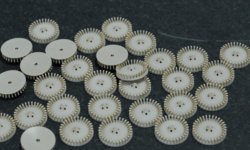Machined parts are everywhere, and it’s easy to see why: CNC machining is suitable for a range of metals and plastics, and machined parts can be fabricated quickly and affordably with no tooling required.
With 3ERP, you can get machined parts and prototypes at fair prices with short lead times, and we have experience working with clients from various sectors. But why should you go for machined parts vs molded parts? Sometimes the choice is obvious, but sometimes it’s harder to decide.
What are machined parts?
What is a machined part? Machined parts are parts made by subtractive cutting machines such CNC mills, CNC lathes, CNC grinders, CNC EDMs, or even manual mills and lathes. Machined parts are widely used for rapid prototyping and mass production.
In manufacturing, machined parts may be contrasted with molded parts, cast parts, forged parts, extruded parts, and 3D printed parts, all of which are made using different techniques. That being said, “machined part” may describe a component made partly using one of these other methods but finished with machining. (A cast metal part with machined features, for example.)
Machined parts might also be referred to as CNC machined parts or CNC parts if they have been fabricated with a digital machining center.
Here are six advantages of machined parts over molded parts.
1. No MOQ
One of the principal advantages of machined parts is the ability to purchase them with no minimum order quantity.
For molded parts, it is necessary to fabricate metal tooling — a process that takes a long time and typically costs tens of thousands of dollars. Machined parts, however, are cut directly from a blank workpiece, which makes it cost-effective to order very small quantities or even one-off parts.
Of course, requiring a very large quantity of (plastic) parts might mean molding is a better proposition. But machining is virtually unique in offering high-quality parts with no MOQ, making it suitable for smaller companies, small production runs, and prototyping.
2. Plausible prototyping solution
Some companies choose to order injection molded prototypes, but it is typically only large companies that can afford to do so. The cost of tooling can make prototyping prohibitively expensive.
Machined parts are suitable and affordable as prototypes because they can be fabricated as one-offs. Machining is also much faster than molding, which means R&D departments can quickly iterate several versions of a part, then put it through whatever testing or assessment is required before moving on to production.
The material versatility of machining also means companies can, for example, order machined parts in several different metal alloys or composite plastics to see which performs best under test conditions.
3. Design freedom
Machined parts can have a wide variety of shapes and sizes. This is because CNC machining is not subject to extreme molding design constraints like thin walls and tapering; machined parts can be thick and robust, but their features can also be fine and detailed.
Although machined parts have some limitation when it comes to, for example, internal sections and deep channels, machining still represents one of the most geometrically flexible manufacturing processes.
Molded parts, on the other hand, must have thin walls and conform to more strict design criteria generally.
Even 3D printing, generally seen as one of the best manufacturing techniques in terms of design freedom, has limitations such as avoiding overhangs. (And extensive support structures may be needed for more complex and sprawling designs, which must be removed with costly post-processing steps.)
4. Quality
Machined parts can be made to a very high standard. Perhaps more importantly, customers can specify tolerances which need to be met by the machinist. This means the machinist or machine operator can take extra time on tight-tolerance parts and individual features.
While injection molds can also be made to tight tolerances, each individual molding cannot be held to such high standard. Moldings produced toward the end of the mold lifespan may lack the definition of earlier units.
Machining also avoids surface quality issues associated with molding such as flow lines, jetting, and flash at the parting line.
5. Lead times
Machined parts can be fabricated faster than parts made via other production processes like molding.
This is partly due to the absence of labor-intensive tooling, but the manufacturing process itself is also highly efficient: some of the faster machining centers equipped with linear guide rails have rapid rates of around 4,000 centimeters per minute (though parts should not actually be machined at those speeds).
The one-step nature of machining and the speed of CNC machining centers combine to make machined parts some of the fastest to fabricate (in low volumes), reducing lead times for shorter time-to-market and practical rapid prototyping.
6. Alterations
Because CNC machined parts are made from a digital CAD file, it is possible to make changes to that digital design right up until the moment of fabrication.
This is useful during R&D and prototyping, when engineers might want to make fractional adjustments to the machined part or create multiple versions. It also reduces the possibility of waste, since defective parts are less likely to be made.
This is a significant advantage for machined parts over molded parts: tooling cannot easily be changed, and it would be a huge waste of money to create a new mold if a last-minute alteration is required.
Does that means injection molding is less advantage? of course not. Injection molding is one of the most efficient ways to build large volume of parts. It is a matter whether your parts fit the process or not. Learn more about injection molding.
3ERP is a prototyping and low-volume production company with expertise in CNC machining and manual machining. Order your machined parts with us now.







